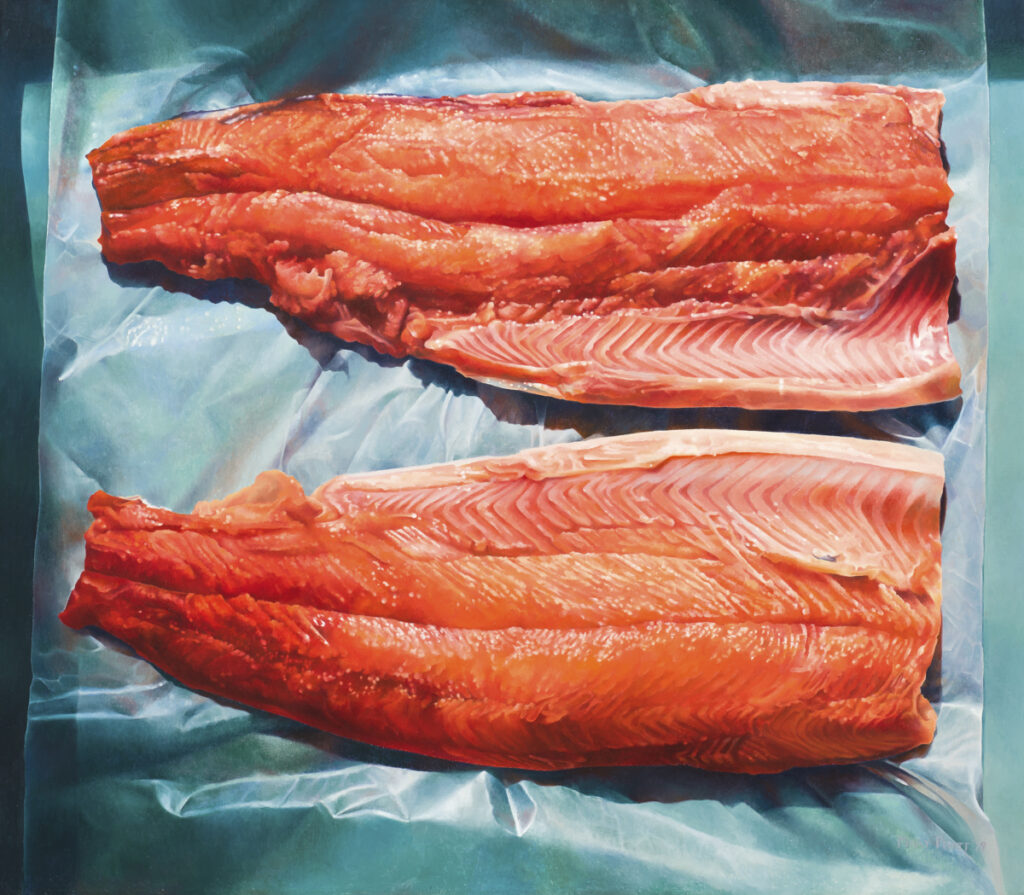1. Split Grilse by Mary Pratt
Nicole Dawkins, Exhibitions Manager
While our collection is best known for paintings of rugged Canadian wilderness, I love how Mary Pratt’s masterful still-life serves up something entirely different. Fleshy. Domestic. Visceral. Equal parts delicious and repulsive. She elevates the gendered, invisible labor of cooking to the sublime in painstaking, photorealistic detail. Who would have thought salmon filets could be so glorious? Chef’s kiss!
2. Twilight, Baie St. Paul by Clarence Gagnon
Tim Savary, Art Preparator
I love the color of the painting. The shades of blue are so vibrant in person, and if you look closely, you’ll notice that he used mauve in a way that really adds dimension. The technique shown in the details, like the birch tree, really makes for a beautiful painting. It’s been a while since we last had it up in the galleries.
3. Dead Sea by Howie Tsui
Amie Takimoto, Development Officer
I vividly remember encountering Howie Tsui’s (b. 1978) striking 10-foot ink-on-paper masterpiece during my walk to the office. This piece commands you to stop and absorb every inch of his storytelling.
His work intertwines fantasy and various drawing styles to convey his family’s diasporic story, resonating deeply with me as a second-generation Canadian. The boats battling through tumultuous waves symbolize the internal struggle of identity—leaving behind some of your ancestral traditions while adapting to a new culture. Each panel powerfully illustrates the complex relationship between cultural heritage and personal experience, reflecting the emotional and geographical journey that shapes our sense of self.
You can view all the details of this amazing work here.
4. Untitled (Garages at Night) by Itee Pootogook
Emily Henderson, Associate Curator: Indigenous Art and Culture
Illuminated by the soft, warm glow of a streetlight, these two Rothko-esque blue and orange garage doors stand sentinel against the hush of a packed layer of snow on a road in town. Itee Pootogook (1951–2014) was a magician of light and color, with his nocturnal compositions holding a particular place in my heart. Pootoogook was one of the greatest contemporary artists to come out of Kinngait (formerly Cape Dorset), Nunavut, and he was celebrated for his reflections of everyday life in his community.
In Untitled (Garages at Night), the artist turns his eye to these doors painted in complementary colors, finding the unexpected beauty in an otherwise ordinary setting.While a lit house in the background and evidence of tire tracks in the driveway suggest the activity of the day before, they are, for now, otherwise blanketed in cool darkness—a testament to Pootoogook’s ability to distill a moment of silence in colored pencil on black paper.
5. Allan Gardens by Ann MacIntosh Duff
Hanna Broker, Assistant Registrar, Collections
Choosing a favorite when you work in the vaults seems like an impossible task because my favorite changes constantly. I adore watercolors and have a deep love for plants. Recently, one work that I have really connected with is Allan Gardens, by Ann MacIntosh Duff (1925–2022). I was fortunate enough to see the entirety of her 70 years of work, and really fell in love with the artist.
The gentle, emotionally fueled use of watercolors and reverence for nature served as a quiet reminder to soften during a difficult time. Duff’s work is a strong contrast to the more boldly painted works in the collection by the Group of Seven. She made space for herself in a world designed to benefit men, and she did so by choosing herself and what she loved, without wavering.
6. Houses, Gerrard Street, Toronto by Lawren Harris
Shi Qiu, Curatorial Assistant
Lawren Harris’ early works from the 1910s particularly resonate with me. These “urban landscapes” focus on life in the city, depicting rows of houses with a warmth and intimacy that contrast with his more grandiose and iconic late style.
This painting in the McMichael collection is one of the largest canvases from this period. The glowing color palette—rich yellows, soft oranges, and warm browns—imbues the scene with a sense of quietness, inviting viewers to appreciate the beauty of everyday surroundings. The house Harris painted in this work still stands today, not too far from where I live, though its surroundings have evolved over the years—a meditation on the relationship between art and our ever-changing lived environment.











